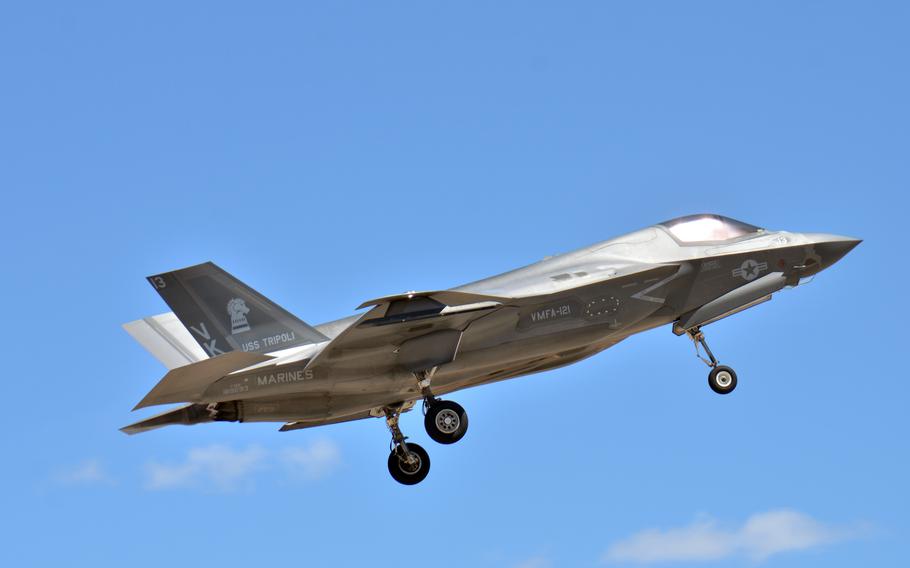𝘾𝙖𝙣 𝙏𝙝𝙚 𝙁-35 𝙍𝙚𝙖𝙡𝙡𝙮 𝘿𝙤𝙜𝙛𝙞𝙜𝙝𝙩 𝙇𝙞𝙠𝙚 𝙄𝙣 𝙏𝙤𝙥 𝙂𝙪𝙣?
Maybe we are asking the wrong question: F-35 may not “need” to dogfight as it will see and destroy enemy aircraft before dogfighting becomes a necessity.
The F-35 is well known for its advanced computing, sensor fusion, long-range targeting accuracy, threat data library, and drone-like surveillance capacity.
But can it dogfight?
The F-35 Controversy That Won’t End
This seemingly loaded question has many layers and variables to consider, as the question has been raised numerous times over the years.
As a multi-role fighter capable of a wide range of missions, some have questioned the ability of the jet to prevail in air-to-air combat against an advanced adversary.
Specifically, a report as far back as 2015 in War is Boring cited details from a report on a test dogfighting exercise in which an F-16 repeatedly out-performed and defeated an F-35 in multiple air-to-air combat engagements.
The War is Boring report, which claimed to cite findings and assessments from a test pilot involved in the exercises, generated a storm of controversial discussion about the future of the F-35 and its capabilities.
But, in the end, it was all for nothing as a key fact was missing.
Not the Real F-35
There are tactical and technical things of great relevance to consider.
However, it first seems essential to explain the circumstance and provide specific context and details left out of the 2015 War is Boring report.
At the time, I remember connecting with the Pentagon’s F-35 Joint Program Office, which explained that the model F-35 involved in the exercise was a flight sciences testing model, which was not “not equipped with the weapons or software that allow the F-35 pilot to turn, aim a weapon with the helmet, and fire at an enemy without having to point the airplane at its target.” That is, as you can imagine, a vast difference from a fully combat-ready F-35.
The F-35 variant used in the exercise was called the AF-2 and, according to the Pentagon’s F–35 JPO, it was a model only intended to test “flying qualities,” not weapons or air-combat capability.
Therefore, comparing an F-16 against this “flight sciences” AF-2 variant makes no sense and does not in any way reflect what would happen in an encounter between an F-16 and a fully-functioning production-quality F-35. Somehow this context was not included in the original 2015 article.
A Bogus Comparision
Given this context, it may not even make sense to raise the question of whether an F-16 can outperform an F-35 in a dogfight.
There are many other critical variables to consider. For instance, war games have for many years shown that the advanced sensing, targeting technology, and computer-enabled data processing are such that the aircraft’s long-range, high-resolution sensors enable the F-35 to see and destroy enemy targets and paradigm-changing ranges.
This means standoff distances where the attacking F-35 is not seen or discovered. This contingency was exactly what happened in an Air Force Red Flag wargame experiment in which a single F-35 showed the ability to track and destroy an entire group of 4th-generation fighters from ranges where it was not itself seen or detected.
What this suggests, therefore, is that perhaps an F-35 may not “need” to dogfight as it will see and destroy enemy aircraft before dogfighting becomes a necessity. Available specs on both the F-16 and F-35 reveal that an F-16 does appear to be faster with a listed speed of Mach 2.05, as compared to the F-35’s max speed of Mach 1.6. At the same time, thrust-to-weight ratios, which reflect acceleration and aerial maneuverability, are somewhat comparable.
The F-35 is listed as having a 1.07 thrust/weight ratio, as compared to a slightly higher 1.24 for the F-16. What is not reflected in available specs to a large degree, however, is the massive difference in mission systems, weapons capacity, targeting, and computing, which likely separates the two aircraft.
With a larger weapons envelope and far superior targeting technology and weapons guidance systems, an F-35 would seem well-positioned to destroy an F-16.